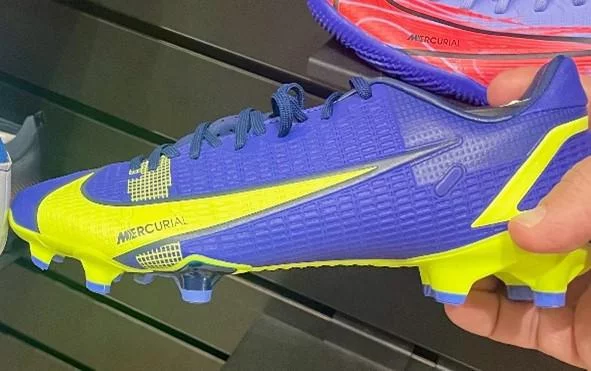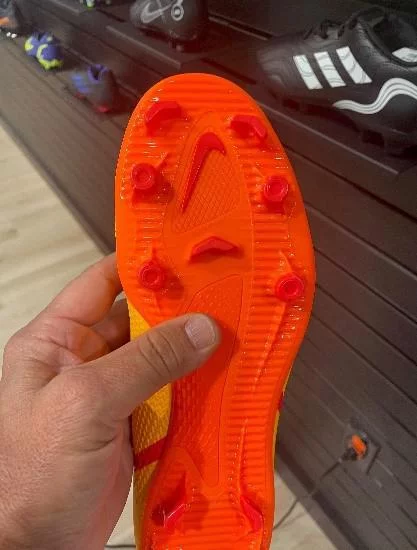As the new soccer season comes upon our community, it is time to think about getting those new cleats for your player. A lot of the shoe shopping for cleats is about the brand, the style and how much will it cost. Well, when it comes to selecting the correct type of cleat for you or your player, there are some things to consider making sure you are getting the most bang for your buck.
No matter what level your player is, comp team or recreational level, you want to make sure that the soccer cleats fit properly and are not too tight or too loose. The correct fit of the shoe is essential to making sure the foot is supported and does not cause other issue that will result in discomfort for your player. So, the first characteristic to make sure of is to make sure the length and width of the shoe is correct. The best way to check is to get both feet measured with a Brannick device (shoe measuring device at the store) when you are standing (not sitting down). This will give the true width and length of the foot. The rule of thumb for the proper length of a shoe is to have about ½ inch space between the length of your longest toe and the end of the shoe when you are standing in the shoes. The width of the shoe also matters. The material of soccer cleats can be semi-flexible, so make sure the player feels comfortable when you try them on and even walk around the store for about 10 minutes with them to make sure they are not rubbing on the side or feel too tight.
The other question is what type of cleat structure to buy? Is there one shape or style or brand that is better than another? There are three different types of cleats that are available: Firm Ground (FG) cleats, Soft Ground (SG) cleats and Artificial Ground (AG) cleats. They differ based on the length of the cleat and the grip and traction needed for a what every surface your player is using. The common cleat is the FG cleat that is normally used on regular grass at parks and typical soccer fields. However, with the development of more artificial surfaces at parks, high schools and colleges, the concern is that FG cleats may cause too much grip since the artificial ground is shallower. The shallow ground with the regular length cleat can cause more stress to the ankle and the knee over time with the number of games the player has in a season or even over the course of year. This can lead to overuse injuries or even acute injuries like ACL or Achilles tears. AG cleats are somewhat shorter than FG cleats and have hollowed out conical structure to reduce the stress to the lower body and reduce the intense friction from artificial grass. The reduced friction allows the cleat not to heat up as much so the life span of the cleat is longer. SG cleats have longer lengths than FG cleats and even must be screwed in. These types of cleats are beneficial when the ground is deep, wet and muddy and you need extra grip. I do not recommend using them on firm or artificial surfaces.


The other question most shoppers ask is do you need the high top or lower top cleat. This is usually up to the comfort of the player. The ankle support that are built into certain cleats are not going to provide you enough support on its own if you have ankle issues. It is usually just a comfort thing. If you have ankle instability issues from rolling the ankle several times, then you will need to use a slim, supportive ankle brace or have the ankle taped prior to playing.
One other factor that you need to consider is the thickness of the sock and the fit in the shoe. It is always a good idea that when trying on new soccer cleats, you wear your soccer socks to get true feel and make sure your toes or sides of your feet do not feel too tight or are rubbing while you walk in the cleats.
It is always important to get the proper shoes to bring out the best performance in your player. The correct fit and correct type of cleat is essential to providing your player with the best equipment as well as reducing the risk of injury.
Soccer Cleats FAQs
Soccer cleats should fit snugly but comfortably, with enough room to wiggle your toes. Your heel should be firmly secured without slipping, and there shouldn’t be excessive pressure points or rubbing against your feet. A proper fit ensures reasonable control, stability, and agility while preventing blisters and injuries. It’s crucial to try on cleats with the socks you’ll be wearing during games to ensure the best fit, and if possible, walk around in them to assess comfort and support before making a final decision.
Whether to wear an ankle brace with soccer cleats depends on individual circumstances. If you have a history of ankle injuries or instability or are recovering from an injury, wearing an ankle brace can provide extra support and help prevent further injuries. However, wearing a brace may limit mobility and comfort for players without a history of ankle issues. It’s essential to consult with a medical professional or a sports therapist to determine if wearing an ankle brace is necessary for your specific situation, as they can provide personalized recommendations based on your needs and injury history.
Soccer cleats typically need replacing every 6 to 12 months, depending on the frequency of use, playing conditions, and the player’s growth. If you play frequently on rough surfaces or in harsh weather conditions, your cleats may wear out faster due to increased wear and tear. Additionally, if you’re still growing, you may need to replace your cleats more often to accommodate changes in foot size. Keep an eye on the condition of the studs, upper material, and overall support of your cleats. When you notice significant wear, loss of traction, or discomfort, it’s time to invest in a new pair to maintain performance and reduce the risk of injury.

